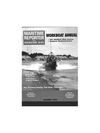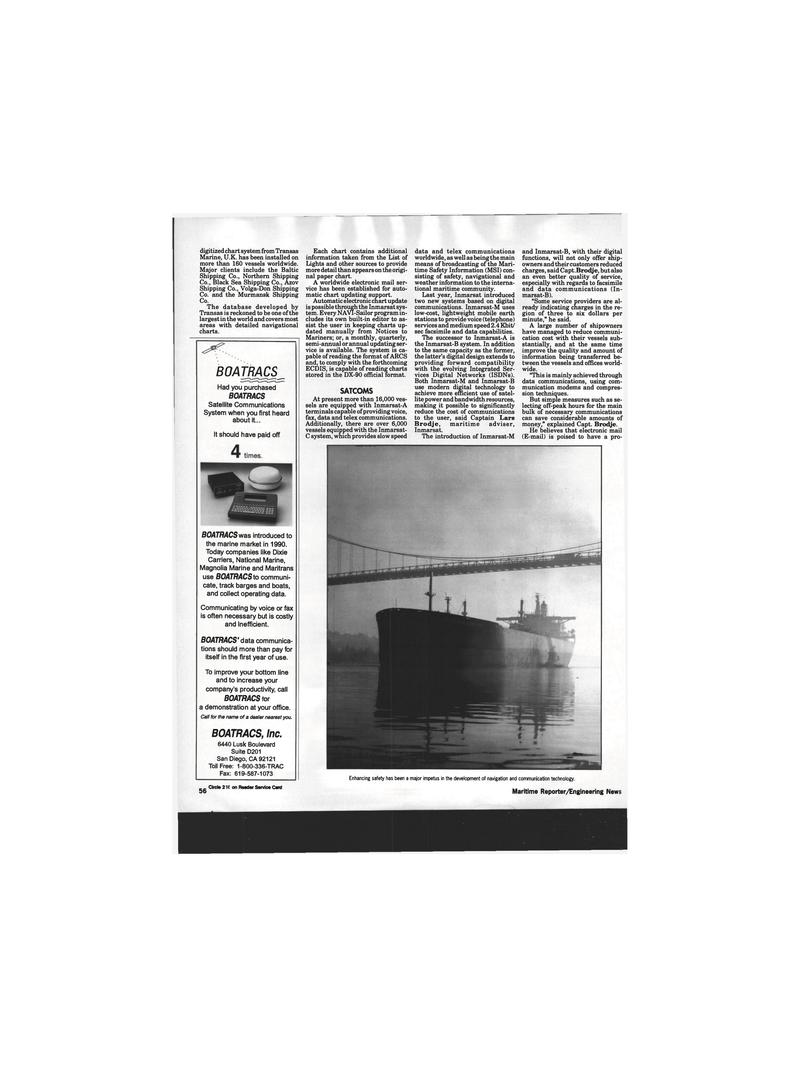
Page 69: of Maritime Reporter Magazine (October 1994)
Read this page in Pdf, Flash or Html5 edition of October 1994 Maritime Reporter Magazine
digitized chart system from Transas
Marine, U.K. has been installed on more than 160 vessels worldwide.
Major clients include the Baltic
Shipping Co., Northern Shipping
Co., Black Sea Shipping Co., Azov
Shipping Co., Volga-Don Shipping
Co. and the Murmansk Shipping
Co.
The database developed by
Transas is reckoned to be one of the largest in the world and covers most areas with detailed navigational charts.
BOATRACS_
Had you purchased
BOATRACS
Satellite Communications
System when you first heard about it...
It should have paid off
BOATRACS was introduced to the marine market in 1990.
Today companies like Dixie
Carriers, National Marine,
Magnolia Marine and Maritrans use BOATRACS to communi- cate, track barges and boats, and collect operating data.
Communicating by voice or fax is often necessary but is costly and inefficient.
BOATRACS' data communica- tions should more than pay for itself in the first year of use.
To improve your bottom line and to increase your company's productivity, call
BOATRACS lor a demonstration at your office.
Call for the name of a dealer nearest you.
BOATRACS, Inc. 6440 Lusk Boulevard
Suite D201
San Diego, CA 92121
Toll Free: 1-800-336-TRAC
Fax: 619-587-1073
Each chart contains additional information taken from the List of
Lights and other sources to provide more detail than appears on the origi- nal paper chart.
A worldwide electronic mail ser- vice has been established for auto- matic chart updating support.
Automatic electronic chart update is possible through the Inmarsat sys- tem. Every NAVI-Sailor program in- cludes its own built-in editor to as- sist the user in keeping charts up- dated manually from Notices to
Mariners; or, a monthly, quarterly, semi-annual or annual updating ser- vice is available. The system is ca- pable of reading the format of ARCS and, to comply with the forthcoming
ECDIS, is capable of reading charts stored in the DX-90 official format.
SATCOMS
At present more than 16,000 ves- sels are equipped with Inmarsat-A terminals capable of providing voice, fax, data and telex communications.
Additionally, there are over 6,000 vessels equipped with the Inmarsat-
C system, which provides slow speed data and telex communications worldwide, as well as being the main means of broadcasting of the Mari- time Safety Information (MSI) con- sisting of safety, navigational and weather information to the interna- tional maritime community.
Last year, Inmarsat introduced two new systems based on digital communications. Inmarsat-M uses low-cost, lightweight mobile earth stations to provide voice (telephone) services and medium speed 2.4 Kbit/ sec facsimile and data capabilities.
The successor to Inmarsat-A is the Inmarsat-B system. In addition to the same capacity as the former, the latter's digital design extends to providing forward compatibility with the evolving Integrated Ser- vices Digital Networks (ISDNs).
Both Inmarsat-M and Inmarsat-B use modern digital technology to achieve more efficient use of satel- lite power and bandwidth resources, making it possible to significantly reduce the cost of communications to the user, said Captain Lars
Brodje, maritime adviser,
Inmarsat.
The introduction of Inmarsat-M and Inmarsat-B, with their digital functions, will not only offer ship- owners and their customers reduced charges, said Capt.Brodje, but also an even better quality of service, especially with regards to facsimile and data communications (In- marsat-B). "Some service providers are al- ready indicating charges in the re- gion of three to six dollars per minute," he said.
A large number of shipowners have managed to reduce communi- cation cost with their vessels sub- stantially, and at the same time improve the quality and amount of information being transferred be- tween the vessels and offices world- wide. "This is mainly achieved through data communications, using com- munication modems and compres- sion techniques.
But simple measures such as se- lecting off-peak hours for the main bulk of necessary communications can save considerable amounts of money," explained Capt. Brodje.
He believes that electronic mail (E-mail) is poised to have a pro- 56 Circle 250 on Reader Service Card
Enhancing safety has been a major impetus in the development of navigation and communication technology.
Maritime Reporter/Engineering New

 68
68

 70
70
